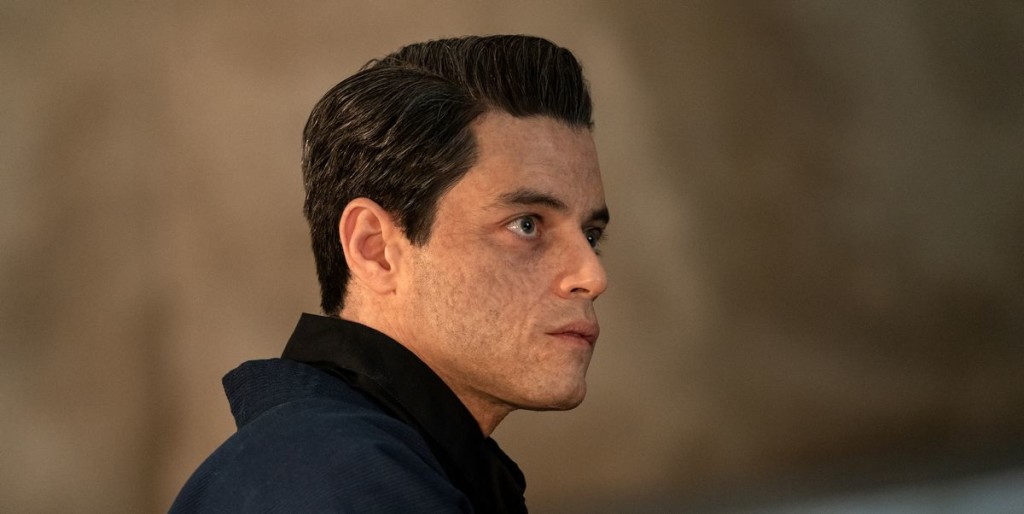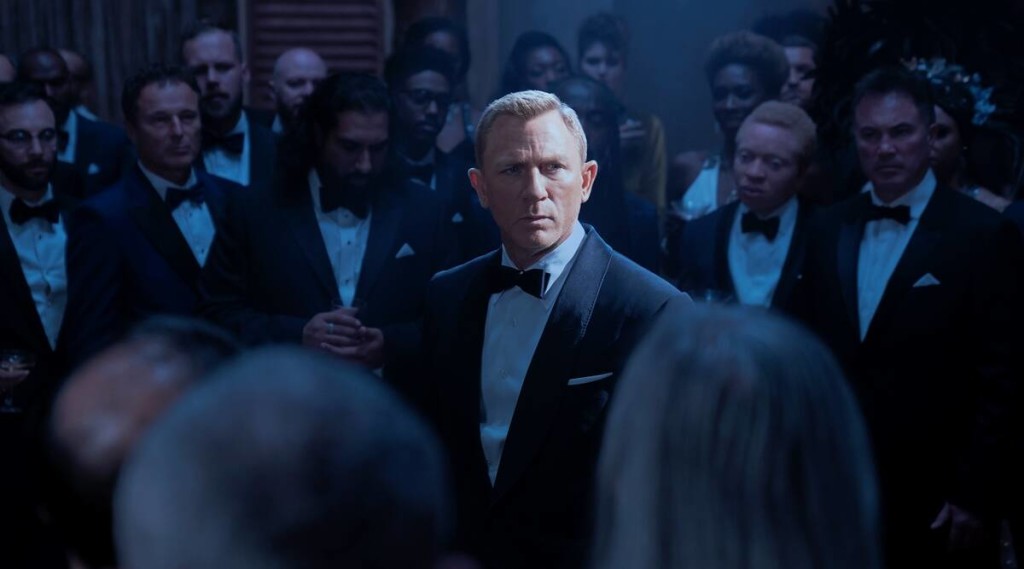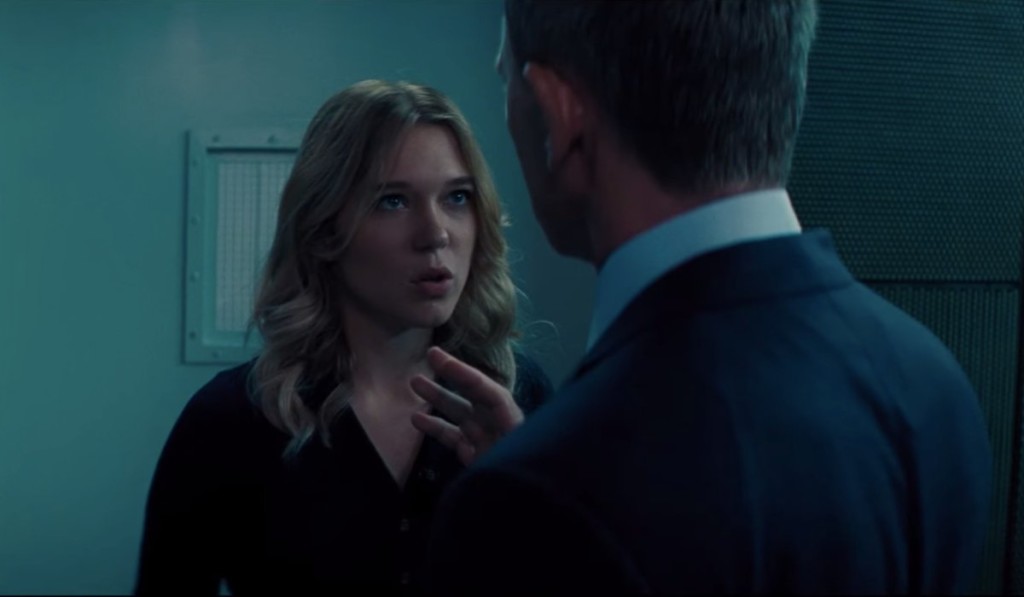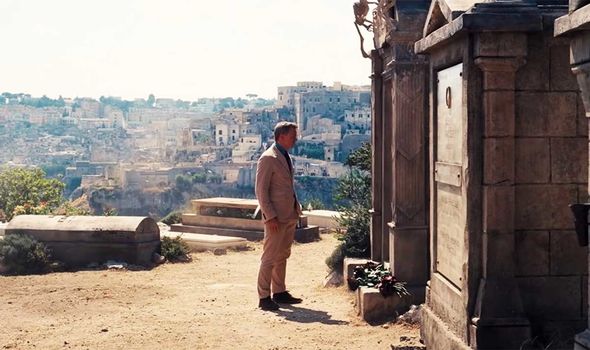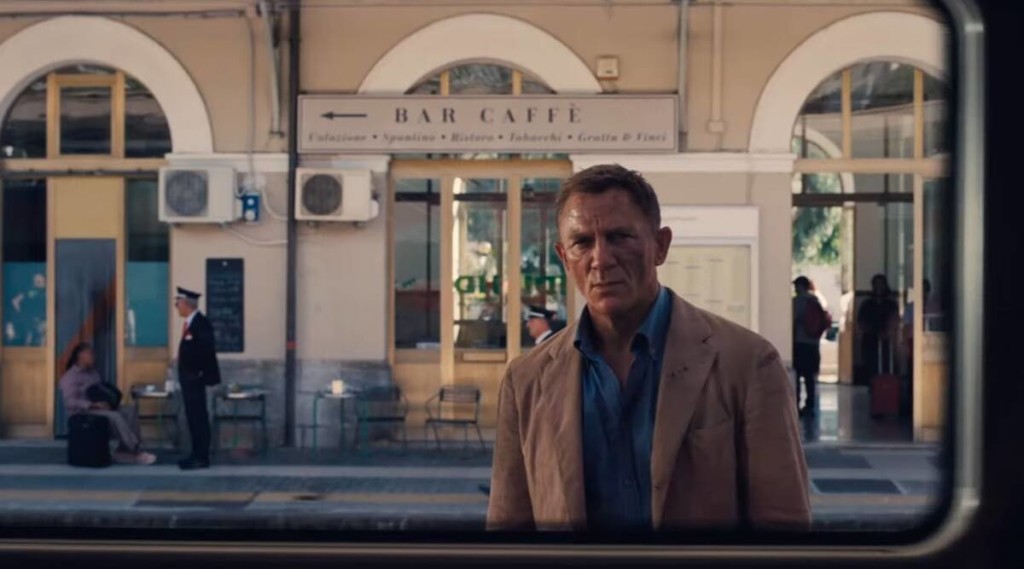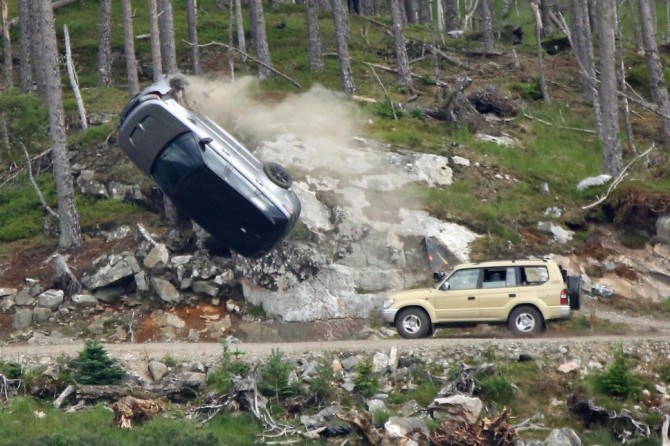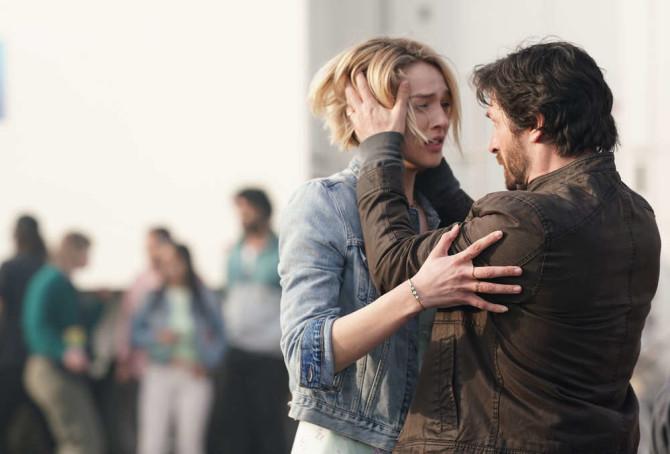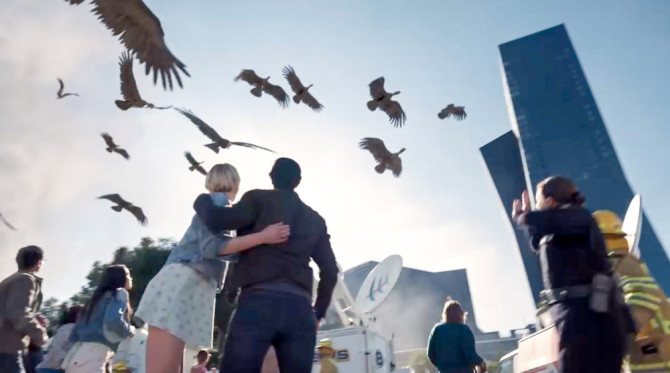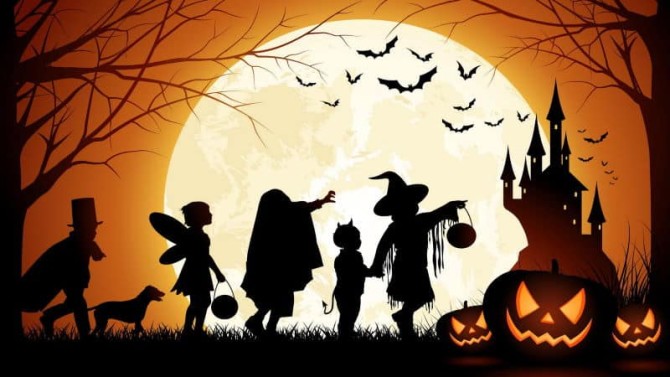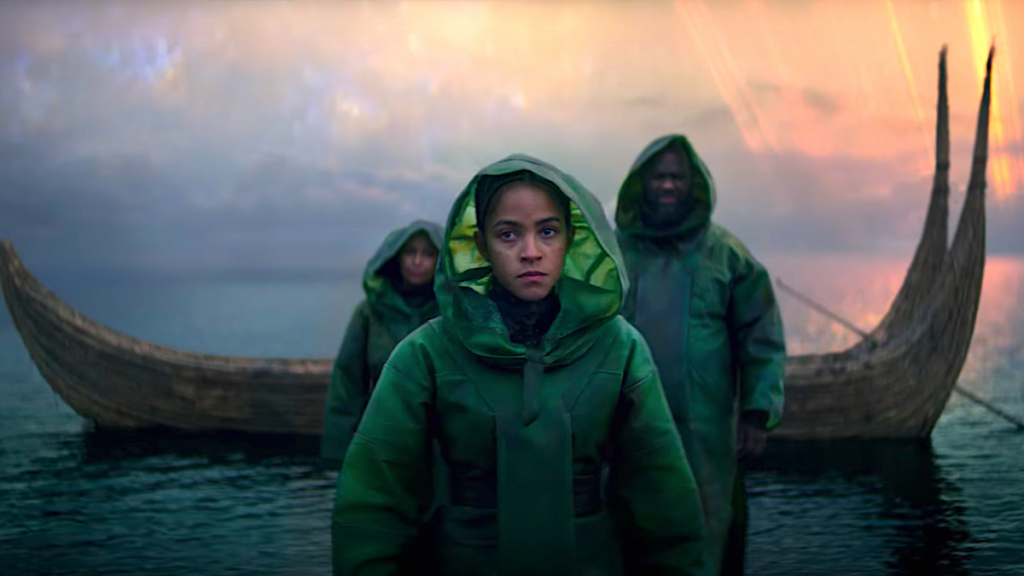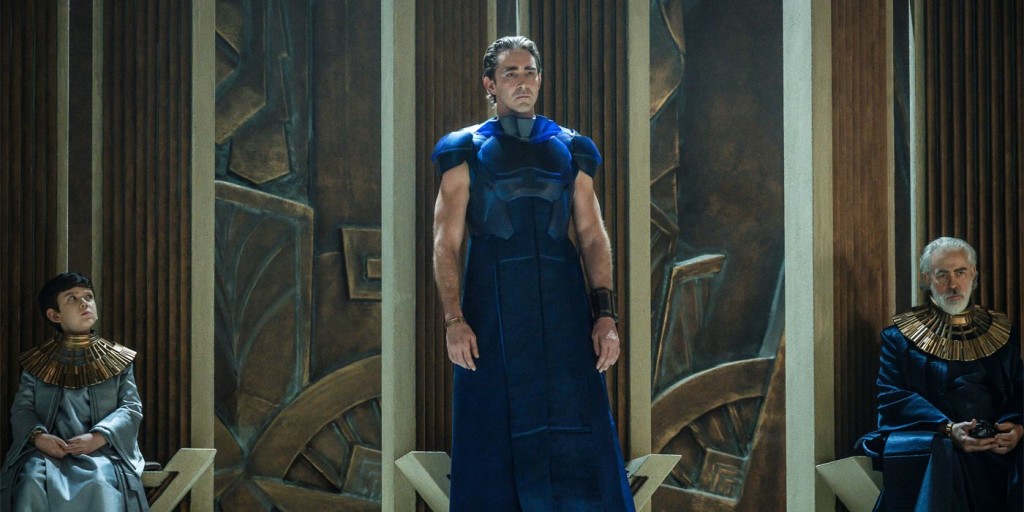Search Results for: the wall
Has a Daniel Craig James Bond film finally won me over???
Genre: Action
Premise: James Bond is pulled out of retirement to hunt down the owners of a dangerous new virus that can target its victims through their specific DNA profile.
About: There probably isn’t a movie that has been more hurt by the pandemic than James Bond’s latest jaunt. The movie had rolled out practically its entire promotion when it was suddenly delayed. And, since then, they’ve been notably gun-shy about when to open it. They finally took their shot over the weekend and it didn’t go well. While films like Venom and Shang-Chi have nearly reached 100 million in their opening weekends, No Time To Die cleared only 56 million. It turns out there was way too much time to die. It’s a sour note on the franchise’s best run ever. But hey, that’s the pandemic for you!
Writers: Neal Purvis & Robert Wade, Cary Fukunaga, Phoebe Waller-Bridge (characters by Ian Fleming)
Details: 165 minutes!
I think James Bond’s weak box office in the wake of recent over-performers Shang-Chi and Venom is telling the market something. Which is that, at this moment, audiences don’t want real life. They want fantasy. Now I know chasing around DNA-specific viruses and hunting down burn victim gardener villains who wear baby masks isn’t real life real life. But Bond is about as close to a “real life” blockbuster as we get these days. And audiences have told you exactly how they feel about that.
Which is too bad. Because in a market that’s becoming increasingly dependent on fantastical characters acting within fantastical worlds, James Bond, in a 180 turn from a decade ago, has become the one unique option on the menu. There’s nothing else like him out there in 2021. So to see audiences turn on him in favor of CeeGeeI McSpecialEfects is a little disheartening.
However, we now know what people want at this point in the pandemic and that is pure escapism. Take us far far away from the real world so we can forget about all this craziness for a couple of hours.
Now, as you know, I’ve had a rough go of it with my buddy Bond these last 15 years. I have not been his BFF. Heck, I haven’t even been an acquaintance he can borrow a couple of bucks from. So, naturally, I wasn’t expecting to be wowed by the latest installment. Let’s see if a bionic eyeball, a face that got stuck in the toaster for too long, and a scene politely borrowed from Silence of the Lambs won me over.
If you haven’t seen the film, James Bond is retired and traveling the world with his wife, French psychiatrist Madeleine. While visiting the grave of an old flame, the grave blows up, and Bond barely survives. Convinced that Madeleine set up him, he leaves her.
Five years later, Bond is lured out of retirement to find a terrorist in Cuba. He and a local female agent, Paloma, infiltrate a SPECTRE party, which stops mid song, as a spotlight reins down on Bond. They knew he was coming! A mist then appears in the air and everyone around him starts dying, even though he’s okay.
Bond and Paloma fight their way out and Bond now has no choice but to rejoin MI-6. His first mission is to visit his nemesis, Blofeld, in a psychiatric hospital, to find out what that misty stuff was all about. But Blofeld will only talk to him if a specific psychiatrist is present – Madeleine!!!
Bond then accidentally kills Blofeld with the same thing that killed the rest of SPECTRE. It turns out that someone’s developed a virus that is DNA specific. You can program it to kill only certain people. While Bond takes that in, Madeleine and her previously hidden 5 year old daughter (don’t worry, we’re told right off the bat it’s not Bond’s) are kidnapped by Lyutsifer Safin, a guy who never wears sunscreen, who has unfinished business with Madeleine. Bond will have to go to Lyutsifer’s secret island to get her back… AND SAVE THE WORLD!
One of the themes of my screenwriting advice is to surprise the reader. Give us things we’re not expecting. It’s one of the hardest things for a screenwriter to do because your mind is hardwired to use stuff you’ve already seen before. Something that’s previously existed is always going to be more prominent in your head than something that has never existed. It takes discipline to ignore that known image, that familiar plot beat, that twist, that turn, from previous movies and come up with your own.
So I have to say I was impressed with how much Fukunaga surprised me. He didn’t do anything earth-shattering. But it became clear to me during many of the movie’s scenes that he was actively trying to keep the viewer off balance. And I loved that.
The first moment this occurred was when Bond went to the grave site of his old girlfriend. I loved that Fukunaga leaned into the dramatic music, the sadness of the moment, all the cliches that usually come from visiting a grave in a movie. I was right on the cusp of falling asleep. And then the front of the grave blew up, launching Bond backwards 30 feet. As soon as that happened, I sat up, and I said, “Okay, we have a movie now.”
The second time this happened was when Bond drove Madeleine to the train station after he believed that she deceived him. We’ve seen many “One lover leaves another lover on a train” scenes before. So I loved that this played out the exact opposite way of how all those scenes did.
In this version, these aren’t two lovers sadly leaving each other. It’s two people breaking up. And the person outside the train isn’t chasing anybody. He’s standing still. It’s the person inside the train, Madeleine, who’s running backwards through the cars to try and convince James with one last look that she didn’t deceive him.
Again, it’s not a crazy good scene. And I’m not sure anybody noticed this but me. But there’s a bigger point to be made here. Which is you could tell Fukunaga and the writers worked really hard to try and make these traditionally stereotypical moments feel fresh and different.
The third time this happened was when Bond went to Cuba to infiltrate the SPECTRE PARTY. When he gets to the heart of the party and everyone backs away as a spotlight washes over him, again, I thought, this is really unexpected. Usually, in these scenes, Bond (or Bourne, or Wick, or Turetto) expertly executes his mission until all hell breaks loose. I was constantly jolted out of my assumptions in No Time To Die and that kept this Bond more exciting for me.
The set pieces were all really good as well. A lot of them don’t transfer well to the page, unfortunately, because they’re built on the uniqueness of the location. Like when Bond is zipping up and down those tiny hilly streets in Italy(?). If you would’ve asked someone how that scene read in script form, they would’ve told you they were bored.
Luckily, there was one relevant “writing choice” set piece we can learn from. That happens after Bond came back to see Madeleine at her rural house, noticed that bad guys were coming, and jumped in the car with her and her five year old daughter. I know it seems, on the surface, like a mundane decision to have the daughter in the car during the chase. But we’re used to seeing chases where it’s only the hero behind the wheel, or the hero with someone in the front seat. We don’t often get kids in the car. And I noticed I was way more into the chase as a result. I was terrified for that little scared girl. It just goes to show there’s always a choice around the corner than can super-charge your scene. So push yourself and ask, “Can I do more with this scene?”
The reason I’m not scoring No Time To Die off the charts is because it still has the same problems as every Bond film. There are so many moving parts to the plot that you need to take a local University course on the movie to keep up. From Project Heracles to Blofeld to SPECTRE to Lyutsifer Safin, I’d consistently get lost as to where Bond was headed and why. It wasn’t as bad as previous Bond films for me. But it’s always hard to enjoy something when you’re never quite sure what’s going on.
**MAJOR SPOILER**
As for Bond dying, I don’t have much of an opinion on it to be honest. It’s not like Han Solo dying where you know he can’t come back. Everyone knows Bond will be back in three years. And they don’t even have to explain why he’s all of a sudden alive again because it will be a different actor playing him and we’ll all just go with it. Also, Bond has never been a real person to me. He’s a wish-fullfiment version of the ideal man, a fantasy of sorts. So I don’t hold any particular emotional connection to him. I guess it makes sense in that it’s the death of Daniel Craig playing the part. But I don’t know. It didn’t do much for me.
In the end, I liked the latest Bond. It’s packed with some really good set pieces and lots of unexpected moments. Worth the price of admission for sure.
[ ] What the hell did I just watch?
[ ] wasn’t for me
[x] worth the price of admission
[ ] impressive
[ ] genius
What I learned (spoiler edition): If you want to sell a twist, LIE HARD to your audience. I actually learned this trick all the way back in Shawshank Redemption. When Andy gets that tiny rock hammer and Red says to us, “Make no mistake, Andy couldn’t do anything with that hammer. It would take a man 600 years to dig a tunnel with that tool.” As soon as he said that, I slumped my shoulders and thought, “Dammit! I thought he was going to escape.” Same thing here. When we meet Madeleine’s daughter, one of the first things Madeleine says to Bond is, “She’s not yours.” It’s so direct and blatant that we buy it wholesale. Which makes the twist that she IS his daughter a shock.
Genre: Horror
Premise: A troubled young surgeon travels to a desolate peak to climb the mountain where her father suffered a mental breakdown years earlier, only to realize halfway up the rock wall that she might be subject to the same fate.
About: This one was on last year’s Black List. Another brand new writer!
Writer: Arthur Hills
Details: 104 pages
Readability: Fast
You guys know how much I love Free Solo. So it’s time to Free Solo ourselves a mountain climbing script review! Join me! Oh, and if you think you can write a better horror script than today’s, make sure you enter the Halloween Horror Showdown!
28 year old Sloane is just about ready to become a surgeon. In fact, we see her operate on one of her first patients, under the watchful eye of a veteran surgeon, only to accidentally let the blade slip and paralyze the guy she’s cutting open. Oops!
Sloane goes home to her boyfriend, Stephen, and laments about paralyzing this guy. We also learn, during this time, that the anniversary of Sloane’s father’s death is coming up. Her father used to be a great climber until one day when he climbed a mountain called Lytta’s Peak and went crazy on it.
Sloane thinks it’d be a good idea to climb the peak herself and finally face the trauma of her father’s death. Sort of like what Reese Witherspoon did in that movie about the girl who walked a 500 mile trail. But unlike Reese, Sloane isn’t going by herself. She’ll be joined by her boyfriend, Stephen, Stephen’s attractive friend, Mia, and the youngster of the group, 24 year old sexual dynamo, Luna.
Off they go to Lytta’s Peak, where Sloane immediately starts seeing things. She sees people in white clothes walking through the forest (but not appearing on her iPhone screen). She sees Mia and Stephen kiss, even though a second later they’re not there. She keeps finding these circles everywhere with a bunch of random designs carved inside.
But things really get nuts when they’re on the side of the cliff and Mia goes plunging to the forest floor. Hashtag Mia’s dead. Around this time, we learn that both Sloane’s dad AND Sloane have SHADOWS that are on the mountain with them. And their plan is to kill everyone climbing the mountain. Including Sloane herself! The only way to defeat them is to get to the top.
“Peak” started out strong and is a good example of how to set up character while keeping things entertaining. The script begins with a teaser. We see a person falling from a mountain. But we don’t know who they are. We’re not close enough to identify them. This creates an immediate mystery that we want answered (and that keeps us reading!).
This is followed by Sloane visiting her father at the psychiatric hospital. One of the best ways to set up characters is through SHOWING. You show us he’s at a psychiatric hospital. You show us that he’s emaciated and worn down. We immediately know where this character is at. Ditto Sloane who’s developing as a character by the writer simply showing us what her family situation is. She has a dad who’s in a psychiatric hospital. That takes a huge toll on someone which creates a richer deeper character in the eyes of the reader. On top of that, the scene is filled with the conflict of the dad not quite being “all there,” despite Sloane desperately wishing he was. It’s heartbreaking.
The next scene happens four years later where Sloane is getting her first chance to operate under the eye of an experienced surgeon. We see how exhausted she is beforehand. So she crushes and snorts some adderall to get her adrenaline pumping for the surgery. Again, another SHOWING moment.
We then watch her operate on this guy and the surgery is the best scene in the script, easily, because she starts bleeding from her nose because of the adderall, which is dripping into her mask, all while she’s making an incision right next to the guy’s spine. Any sudden move could paralyze him for life. It’s an intense scene that really draws you in. Again, this is the goal with writing. You want to set up WHILE entertaining. You don’t just want to set things up and that’s it.
A couple of scenes later we’re driving to the mountain. This section is entertaining as well because the writer sets up that Stephen and Mia are really close. To the point where Sloane is suspicious of their relationship. This creates a ‘dramatic irony’ situation within the car where Mia playfully chats away with Stephen with Sloane watching on, trying to pick up cues if there’s more there than friendship.
In that case, it’s the CONFLICT – Sloane disliking and being suspicious of Mia – that keeps the reader entertained. If you don’t think that’s worthy of mentioning, let me just say that I read tons of scenes like this where the writer doesn’t make any attempt to create conflict within the ride, so all the characters are doing is babbling on, setting up exposition, trying to be funny. These are always less entertaining than scenes where the writer is actively looking to inject conflict into the conversation.
So I was encouraged after those first 20 pages.
And then the writer made the same mistake so many writers writing “Is my protagonist going crazy” storylines make. Which is to start injecting that classic repeated beat of something weird happening (sees someone dressed in white walking through the forest, sees Mia and Stephen kiss) only for it to be in her head. And it just ruined the story for me.
I don’t know why writers think this is interesting. Once you establish the character is seeing things that aren’t there, we know every weird thing that happens from now on is going to be another hallucination. Where’s the suspense in that? The mystery? We, the reader, are now ahead of you, since we can predict these things. And the second the reader gets ahead of the writer, the script is cooked.
I don’t want to completely undersell the story because this idea of peoples’ shadows orchestrating death and mayhem is kind of cool. And it does get rid of some of the story’s predictability. But it wasn’t cool enough to win me over.
There’s a broader topic to explore here about first and second acts. There are writers who are good at first acts and bad at second acts. There are writers who are good at second acts and bad at first acts. But there aren’t a lot of writers who are good at both. And that’s because the requirements for each are so different.
The first act is about setting up the plot and characters then sending your hero off on their journey. The second act is double the length and about pushing your hero towards their goal, throwing obstacles at them, giving us compelling twists and turns, and, of course, exploring all of the relationships in a compelling way, including the main character’s relationship with himself.
To nail that second act, you have to stay away from repeated beats as much as possible. Once you establish a pattern, you risk boring the reader. That happened here with all the, “What’s that! Did you see that!???” fakeouts.
Look, I’m not saying that any script about going crazy is going to suck. I loved Black Swan. I liked Taxi Driver. I like The Shining. But it’s a pretty short list from there on out of ‘going crazy’ movies that are good. And I think that’s because, ironically, ‘going crazy’ movies need a higher level of SOPHISTICATION to be convincing compared to other genres. And all three of those movies showed a lot of sophistication in the way the craziness was built into the story.
Mileage may vary here if you’re into ‘going crazy’ narratives. You might like this because it’s kinda fun. But once I figured out the story’s pattern, I got bored. So it wasn’t for me. P.S. I feel VERY confident that we can find a better horror script than this for Halloween Horror Showdown. Which would mean we’d find ourselves a Black List script. So get writing!
[ ] What the hell did I just read?
[x] wasn’t for me
[ ] worth the read
[ ] impressive
[ ] genius
What I learned: I would strongly suggest that you never end your movie with your character waking up strapped to a bed in a psychiatric hospital. It’s just so obscenely cliche at this point. I’ve read that ending more times than I can count.
Is La Brea the new Lost?
Genre: TV Pilot/Drama/Sci-Fi
Premise: (from IMDB) A massive sinkhole mysteriously opens up in Los Angeles, separating part of a family in an unexplainable primeval world, alongside a disparate group of strangers.
About: Here’s series creator David Applebaum on his high concept show: “The genesis of the idea was just an image of a sinkhole opening in the middle of Los Angeles, and it was just an image that I couldn’t shake. I had never seen a show open that way with something so dramatic and I knew I wanted that to start the story, but didn’t know anything else. But started asking so many questions about why does the sinkhole open? Where does it go? Who are the people that fall in? And then, once you’re starting with those questions, you start to create a world of characters in situations. And then from there, a thousand other things happen, but it really just started with an image.”
Writer: David Applebaum
Details: 60 min
If you’re anything like me – and you probably aren’t but let’s just pretend for a second you are – you miss “Lost.” That show took over my life. For a good five years, everything was built around Wednesday’s at 8 o’clock. I couldn’t get enough of that show. Even when the Lost backlash began and everybody started piling on JJ (“HE ONLY KNOWS HOW TO ASK QUESTIONS! NOT ANSWER THEM!”), I was still Team Lost. Even detractors have to admit that there was something magical about that show. And if you disagree, I have the ultimate argument to prove you wrong.
For the next five years, all anybody did was try to recreate Lost. AND FAILED. Here are just some of the shows that attempted to become “the next Lost.” Flash-Forward, Threshold, V, The Event, Invasion, and the most successful of the failures, Heroes. People think Lost was a bad show? No no no no no. THOSE were bad shows.
It turns out Lost was lightning in a bottle, the perfect TV idea, never to be repeated again.
Or maybe not.
Recently, there’s been a resurgence in trying to recreate Lost, probably because writers who loved the show and were in that target demographic (18-25) when it aired have now become seasoned enough to be able to pitch their own shows. Westworld sort of re-started the “Lost” like formula. A couple of years back there was Manifest, which is now in its final Season on Netflix. And today we get La Brea, which is the most Lost-y show yet. Hell, one of the characters in the pilot literally says, “Or maybe we’re just stuck in an episode of Lost.”
The reason I even gave La Brea a chance at becoming the next Lost is because it has a genuinely cool premise. Let’s take a look at how the pilot shakes out.
Set in Los Angeles, the show starts off with mother, Eve Harris, driving her teenaged kids, Josh and Izzy (who has a prosthetic right leg), across town somewhere, when, all of a sudden, a giant sinkhole appears near La Brea and 3rd Street, swallowing up five square blocks of real estate. Everyone in their cars and inside of buildings fall into the hole of death, including Eve and her son (Izzy and her prosthetic leg are able to outrun the hole).
After the government sets up a perimeter around the hole and begins a clean-up process, Eve’s husband and former Air Force pilot, Gavin, swoops into town. But he’s not just here to hug his daughter with the prosthetic leg. No. You see, several years ago, Gavin had strange visions which got him kicked out of the military. He’s having those visions again, but this time they’re more specific: he can see his ex-wife and a bunch of other people STILL ALIVE.
Cut to a hilly tree-lined rural land and a giant piece of building in the middle of it, along with a bunch of cars and dazed people stumbling around. I’ll save you the mystery. Eve and everyone else on La Brea are a few hundred thousand years in the past, in Los Angeles BEFORE it was Los Angeles. “Those are the Hollywood Hills,” someone points out. The show then sets up a scenario where we will jump back and forth between the past and the present until somebody figures out the mystery of how they ended up here and, hopefully, a way to get home.
Let me just go ahead and say that, so far, I like this show.
At times the writing is juvenile. Frustratingly so. Yet it’s a really cool premise with all sorts of possibilities. I mean, towards the end of the pilot, a group of our time-traveling characters get into a standoff with a saber-tooth tiger. Count me in on that!
But I am oh so worried. This show is already exposing weaknesses and we’re only in the pilot episode. As a means of comparison, Lost didn’t show any cracks until its third season, a full 50 episodes in. Let’s go over a few of these concerns.
The dad had visions – This is extremely concerning. Just going off the odds, what are the chances that someone who has special visionary powers will have a wife that, three years later, will be involved in the single most unique event in the history of humanity? Clearly, the only reason he has this power is that the writers needed a way to bring the husband into the military mix. So they gave him this special power that the military needs. It’s a lazy juvenile coincidental choice that makes me think more choices like it are coming. Although I hope I’m wrong!
The default is melodrama – One of the reasons that cable has usurped the buzzy one-hour drama from networks is because they leaned into more realistic interactions between people. Meanwhile, the network shows are still stuck in melodrama. When your big opening scene turns ultra slow motion while focusing on a prosthetic leg JUST BARELY pushing away from the final crumbling concrete of a giant sinkhole, that’s melodrama. Even Lost knew this. Whenever Jack was saving someone, it felt genuine. It didn’t feel like this over-acted silliness that networks seem to think audiences still like, and which we’re seeing here.
The cars and buildings didn’t survive the fall from the sky but, somehow, all humans did – This is something one of the characters even says. “How are all the cars damaged but we’re okay?” “I don’t know,” another person says. I know they’re going to try and answer this question at some point but it’s clear that the reason the people survived the fall is that they wouldn’t have a show if they didn’t. There is no answer down the road that will adequately explain this, which means they’ll have to construct some nonsensical answer that will ultimately disappoint us.
There are a couple of things going on here. First, the pilot is the foundation for your story. If it’s not solid, the episodes that follow it are going to be even less solid. To make matters worse, each subsequent episode will display the law of diminishing returns. This is why bad shows seem to get worse with every episode. I’m hoping La Brea is an exception to the rule but I’m not optimistic.
Second, a good mystery isn’t built off of a coincidence you need for your story to work. A good mystery is something you create for the sole purpose of the mystery alone. So everyone surviving a fall from 30,000 feet in the air in order for you to have a show isn’t a designed mystery. It’s more of a “paint yourself into a corner” mystery. Polar bears on a tropical island. THAT’S a good mystery because it was specifically designed into the show.
Despite all this, I was into all the stuff that was happening in the pre-historic era. I love the idea of a technology-dependent people being thrust into a past where they’ll be tasked with surviving giant wolves, saber-tooth tigers, cave men, and who the hell knows what else. The power of any show basically comes down to its ideas. Are the ideas imaginative and dramatically compelling? So far, La Brea has that going for it.
I’m just worried they’re going to get in their own way. Will the sloppy conveniences continue? Will the melodrama continue to be laid on too thick? I hope not. Because I would love more than anything to finally be able to watch the next “Lost.”
[ ] What the hell did I just watch?
[ ] wasn’t for me
[x] worth the stream
[ ] impressive
[ ] genius
What I learned: David Applebaum got his first job as a P.A. in the writer’s room of the O.C. Desperate to become a writer on the show, David pushed to move up, eventually becoming a script coordinator (in charge of reading and distributing scripts to everyone on the production and cast) but they wouldn’t give him a writing job. Applebaum said that was his first big lesson learned in Hollywood. “Don’t stay anywhere just because it’s comfortable. Keep your end goal in mind and make choices that help you achieve that goal.” Because they clearly weren’t going to let him write on the O.C., Applebaum quit. He finally got his first paid writing job several years later on a pilot that didn’t get picked up called King’s English. A couple of years after that, he started writing on The Mentalist.
Got a horror script? Good news! Scriptshadow has a screenwriting competition for you. And it’s absolutely free! Send your horror script to me by October 21st and I’ll pick the best five concepts to compete for the Halloween Horror Showdown title, which will take place that very weekend! The winning script will get reviewed here the following Friday, just three days from Halloween!
What: Halloween Horror Showdown
Genre: Horror
When: Entries are due Thursday, October 21st, 11:59 PM Pacific Time
How: Include title, genre, logline, Why We Should Read, and a PDF of your script
Where: carsonreeves3@gmail.com
Can’t wait to see what you horror mavens have cooked up this time!
P.S. I decided not to review Turnpike Jackknife for reasons I’ll get into in the comments. Sorry about the tease!
Star Trek is Star Wars for geeks. Guardians of the Galaxy is Star Wars for the cool kids. Is Foundation Star Wars for adults?
Genre: Sci-Fi/1 Hour TV Drama
Premise: When the galaxy’s premiere mathematician concludes, via a complex equation only he understands, that it is inevitable the Empire will fall, the leader of the galaxy exiles him to a remote planet and goes about trying to prevent his prediction from coming true.
About: Based on one of the most famous sci-fi novels of all time, the expensive ‘Foundation’ is Apple TV’s official entry into the tentpole TV space (unless you count “See”). Foundation is a major influence on many of the sci-fi works we know today, including Star Wars. George Lucas borrowed some of the Star Wars terminology straight from Foundation, most notably, the ‘Empire,’ but also his obsession with clones. The series is being led by love-him-or-hate-him screenwriter, David S. Goyer (The Dark Knight, Man of Steel), who calls the Foundation show the biggest writing challenge of his life, as the narrative will span thousands of years.
Creators: Josh Friedman and David S. Goyer (original novels by Isaac Asimov)
Details: Pilot episode was about 65 minutes
The only reason I bought the Apple TV+ service was to see this show. Then I found out it wasn’t coming out for another year and a half! So I waited and I waited and I waited and then I waited some more, and FINALLY I got my Foundation.
Meanwhile, I have no idea if anybody else besides me is interested in this show. I think it looks amazing. Star Wars for adults if it nails the execution. Yet I haven’t heard anyone else mention Foundation, which makes me wonder just how many Apple TV subscribers there really are. Or maybe it’s just not as buzzy of a show as I think it is. Let’s find out together.
Foundation is set in the far off future after the entire galaxy has been populated. This galaxy is run by a clone emperor named Brother Day. Brother Day keeps cloning himself so he can rule forever. He actually rules alongside his older clone, who was once in his position, and a younger clone, who will eventually take his position.
Off on a remote planet we meet a brilliant young mathematician named Gaal Dornick. Gaal has been called to the central planet to work alongside the most accomplished mathematician in history, Hari Seldon. After a light-years long flight, she arrives at the capital city, meets Hari, who instantly tells her, “Oh yeah, um, I forgot to tell you. They’re going to arrest you tomorrow.”
Gaal is like, “Excuse me???” Hari explains that in his latest equation, he has predicted the fall of the Empire. It is inevitable and will last millennia. He knows Brother Day won’t like that, so he’ll arrest Hari and anyone working with him. Sure enough, the next day, Gaal is arrested. She is told by the Empire to look at the equation and, regardless of it is right or not, to say it is wrong. That way the entire galaxy doesn’t freak out.
But in a courtroom battle, Gaal confirms Hari’s findings. Brother Day is brother pissed. Hours later, the giant space elevator that doubles as a landing port for all ships coming to the planet, is blown up by two terrorists, and falls onto the planet, killing upwards of 100 million people, seemingly confirming Hari’s prediction.
At the last second, Brother Day has a change of heart and exiles both Gaal and Hari to a remote planet on the outskirts of the galaxy. They are to work on a solution to the Empire’s demise. When they find one, they can come back. And that’s the end of the pilot episode.
One of the issues with tackling stories that have an enormous scope is getting lost in the scope. The writing becomes more about the world building and “showing off” than it does telling a story that actually keeps people entertained.
The first 30 minutes of Foundation operates this way. It’s powerful people in big rooms saying random things about situations we only barely understand. There’s no form to any of it. And, therefore, no function either. It is 30 straight minutes of ‘who the hell cares?’
But then the court room scene comes. This is the scene where Gaal will either lie and say that Hari’s conclusion was incorrect, in which case she’ll go free and live a normal life, or she tells the truth, which is that Hari is right, in which case she’ll likely be killed.
You’ve finally written a compelling scenario. A courtroom scene has form. I understand a courtroom scene. I didn’t understand 1000 people standing in front of Brother Day as he babbled on about the warring factions of the Fifth Segmentia of the Clororo District. That scene has nothing in it that’s dramatically relevant.
A courtroom scene, meanwhile, is not only something I’m familiar with (and therefore I understand what’s happening), but something with consequences. The stakes of the scene are someone’s death. THAT’S how you invest readers. Always remember to create scenarios that a) people understand and b) have consequences.
Another scene that I understood was two terrorists blowing up a significant structure. Terrorism for a cause is something we’ve seen in our lifetimes. That’s why I’m familiar with and understand it. Again, you have to place us inside scenarios that we understand in order for them to have a dramatic effect.
How am I supposed to understand, or care, about two planetary representatives staring at a wall of art? Staring at a painting on a wall while saying random things to each other has no dramatic consequences whatsoever. It’s a banal empty scene. And yet that was typical of the scenes early on in the pilot.
I understand getting exiled to a planet. That makes sense to me. I’ve seen that before. I know that’s happened to leaders throughout time, like Napoleon. So it was a scenario, again, I could participate in.
In setting up this world for the audience, Goyer got lost in the details and forgot to create dramatic scenarios that actually entertained people AS WELL AS informed them. You can’t make that mistake with a pilot. People just don’t have the time in 2021. Do you know how many other shows there are out there? The list is endless. You can’t do anything that makes someone think, even for a second, “I wonder what else is on?” I seriously considered ditching this show 30 minutes in. The only reason I kept watching was because I was going to review it. But I’m sure others, after watching the opening, said, “What is this stuffy boring sci-fi bullshit?”
The courtroom scene and the space elevator destruction ended up saving the pilot but the weak first half sets up some concerning questions about where the series is headed. Is it a good idea to create a show without a single happy character? Without any humor at all? A show needs balance. Or at least a small variation in tone. The tone here is 5th gear super serious at all times. Has there ever been a show like that that’s succeeded? I’m asking honestly.
This brings me back to Friday’s Amateur Showdown winner where I had a similar problem with the script. The family was really serious. The script took a really long time to get going. I think writers continue to use the excuse of, “Well, I had to set up the characters and the story” to justify it being boring.
Don’t do that. Do both. Set up the characters and story WHILE you’re entertaining the audience. It doesn’t have to be Sophie’s choice.
Star Wars is one of the best examples of this. Darth Vader isn’t Brother Day when we meet him, casually strutting around his palace, looking concerned about the state of affairs. He’s too busy relentlessly pursuing the people who stole the Death Star plans. He’s active. We’re meeting a character but we’re also BEING ENTERTAINED while doing so. I honestly believe that the only reason writers don’t do both of these things at the same time is out of laziness. It’s easier to set up rather than set up and entertain.
Despite me sounding like I didn’t like Foundation, I’m still hopeful. I really want this series to work because I think a Star Wars for adults would be awesome. The Mandalorian has shown me that it’s more interested in satisfying the younger fans than the older ones. So it would be cool if I had something targeted towards my demo.
Is this show on anyone’s radar? Am I the only one watching it? Do any of you watch anything on Apple TV? I’m curious because I never hear anyone talk about Apple other than Ted Lasso so I’m wondering if anyone even knows it exists.
[ ] What the hell did I just watch?
[ ] wasn’t for me
[x] worth the stream
[ ] impressive
[ ] genius
What I learned: Offer foreknowledge to the reader to create a more compelling scene. There’s a scene in the first half of Foundation where Brother Day visits an older artist (or maybe he’s an art curator – it’s unclear) and starts chatting with him. We gradually get the sense that he’s unhappy with this guy for something that happened recently, although it’s unclear what that something is. Finally, at the end of the conversation, he shoots and kills the man. The scene is a dud because we were given no prior information on who this man was. We had no idea Brother Day was even coming to see him until the scene started. In other words, we didn’t have nearly enough information to actively participate in the scene. We needed the writer to give us more info so that when Brother Day walked into that room, we knew he suspected this guy of something and we knew that he was thinking of killing him. That way, we would’ve felt suspense as well as fear. But when you don’t tell us anything ahead of time, we’re lost in the scene, especially this early on when we don’t know any of the characters or what they’re up to. It was a miscalculation and one of the reasons the first 30 minutes felt like stuffy setup rather than an entertaining show.


